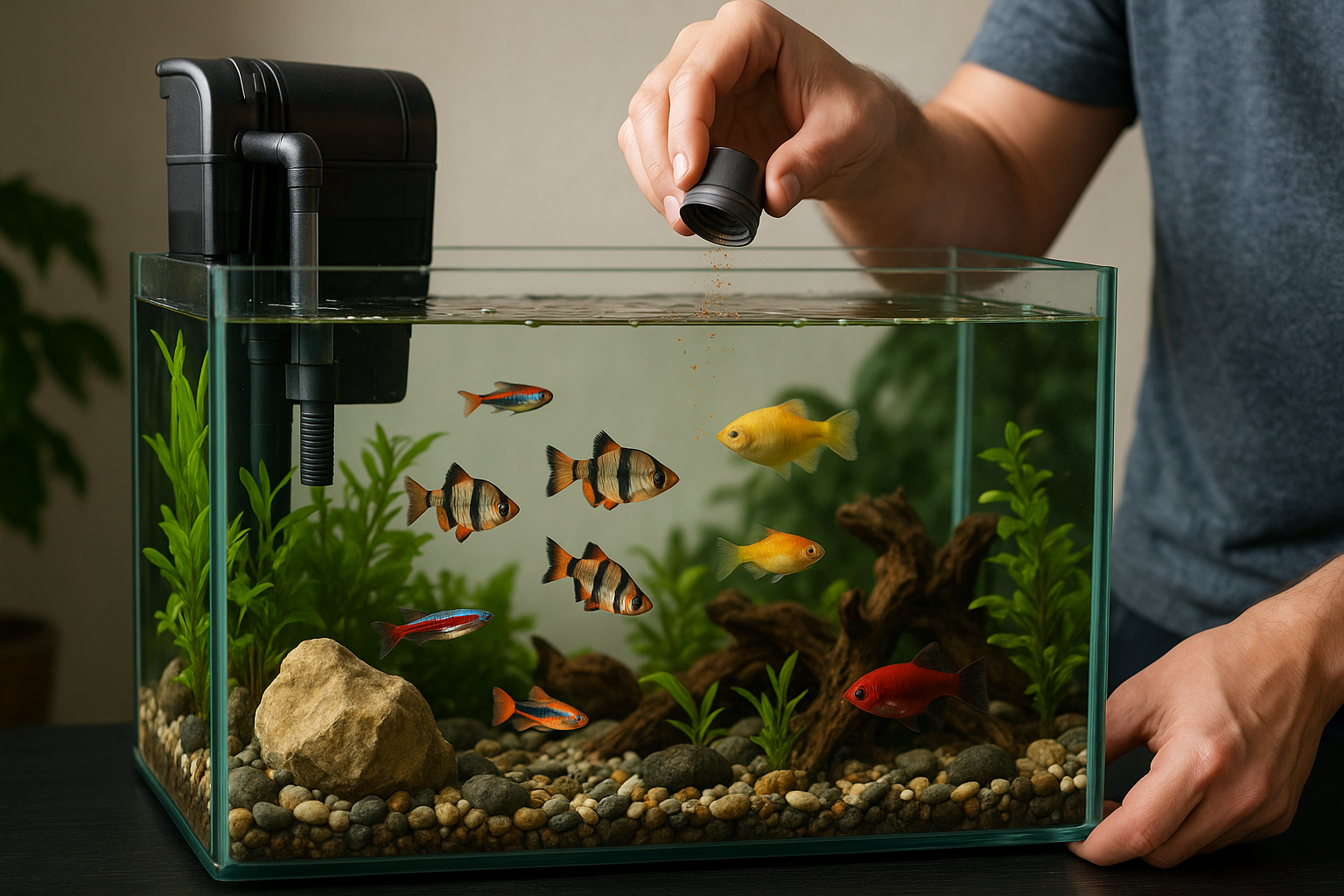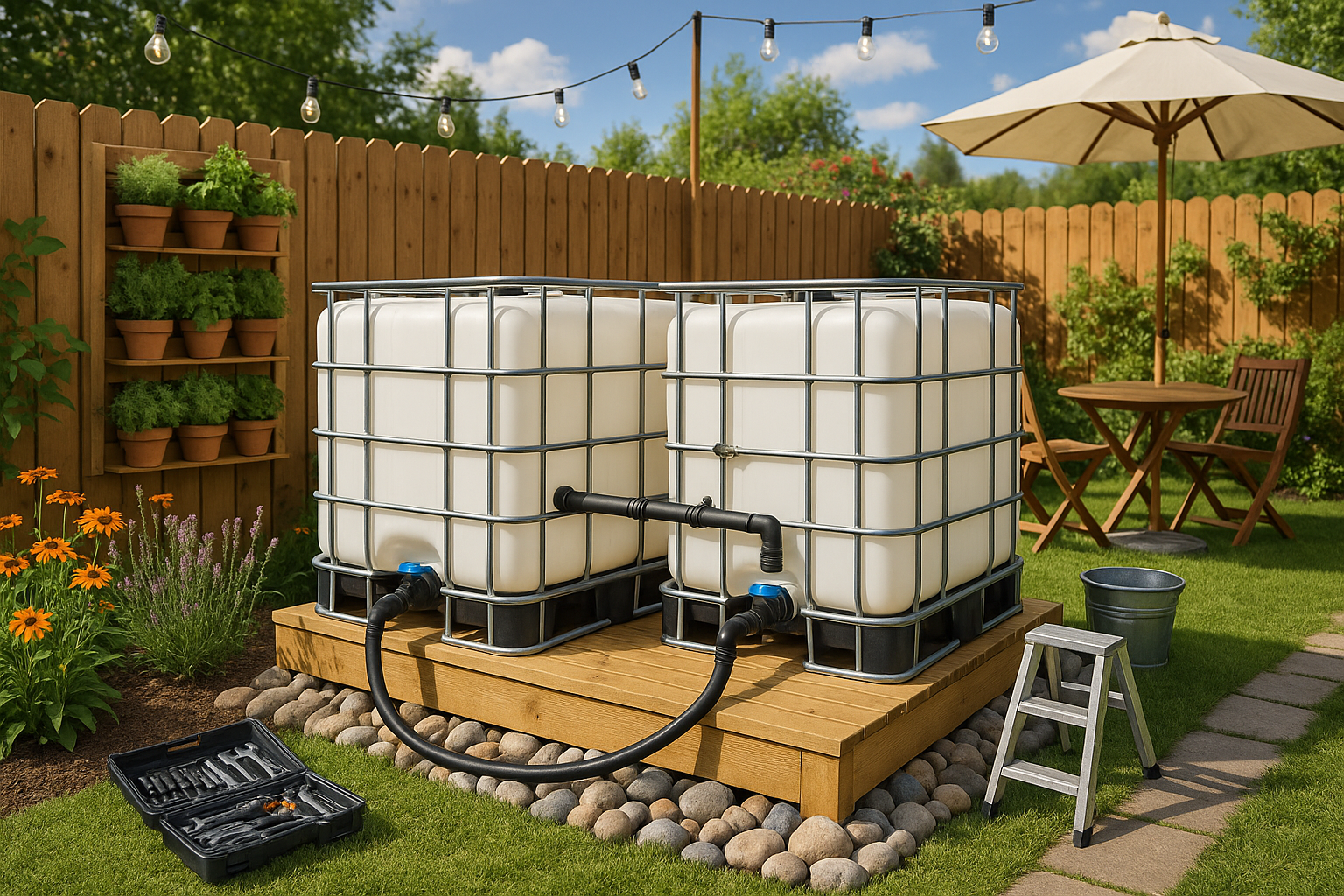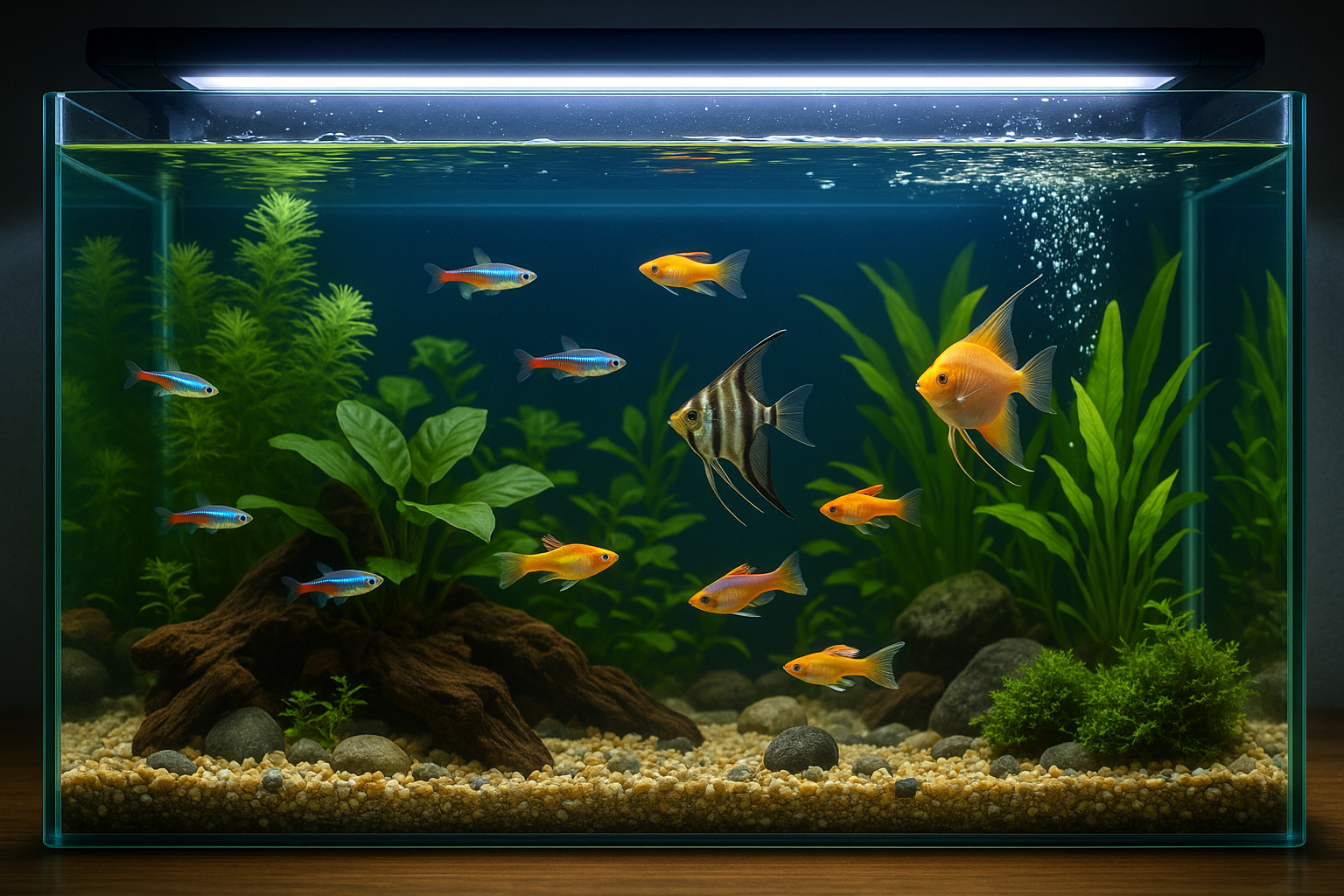Imagine a world beneath the water’s surface, a tranquil realm where vibrant colors glide gracefully, and serene movements create a calming ballet. 🐠 For many, an aquarium is more than just a decorative element in a room; it’s a living piece of art that brings joy and relaxation. However, maintaining this delicate ecosystem requires more than just filling a tank with water and tossing in some fish. Fish, like any other pet, need the right environment, care, and attention to thrive.
In this comprehensive guide, we will dive deep into the essentials of fish health and happiness. Whether you are a novice aquarist or a seasoned hobbyist, understanding how to create and maintain a thriving aquatic environment is key. From water quality to dietary needs, every aspect plays a crucial role in ensuring your aquatic friends live their best lives.
Our journey begins with one of the most critical aspects of fish care: water quality. Maintaining clean and stable water conditions is paramount to preventing diseases and promoting healthy growth. We’ll explore the significance of parameters like pH levels, temperature, and ammonia, and discuss the tools and practices that can help you monitor and adjust these factors effectively.
Next, we’ll turn our attention to nutrition. 🥕 Just as with humans, a balanced diet is vital for fish. We’ll examine the different types of fish food available, from flakes to live feeds, and how to choose the right diet based on species, size, and health requirements. Moreover, understanding feeding habits and preventing overfeeding can make a significant difference in their well-being.
But it’s not just about the water and food. The environment in which your fish live is equally important. Creating a stimulating and safe habitat involves selecting the right tank size, choosing appropriate plants and decorations, and ensuring compatibility among species. This section will guide you in designing an underwater sanctuary that supports both the physical and mental health of your fish.
In addition to environmental factors, the role of regular maintenance cannot be overstated. Cleaning routines, filter management, and routine health checks are essential practices that keep your aquarium in top condition. We’ll provide you with a detailed maintenance schedule and tips to make these tasks easier and more efficient.
Lastly, we’ll address common health issues that fish may encounter and how to identify, prevent, and treat them. From recognizing signs of stress and illness to understanding treatment options, you’ll be equipped with the knowledge to act swiftly and effectively.
Throughout this article, we’ll share expert insights, practical tips, and firsthand experiences to empower you in providing the best care for your aquatic companions. With the right knowledge and commitment, you can create a vibrant, thriving aquarium that not only captivates the eye but also ensures your fish are happy and healthy.
So, whether you’re aiming to enhance your current setup or embarking on your first aquatic adventure, this guide is your roadmap to success. 🗺️ By the end, you’ll have a clear understanding of how to meet the needs of your fish, making you a confident and capable caretaker of your underwater world. Let’s get started on this exciting journey to keep your fish happy and healthy!
# Keep Your Fish Happy and Healthy: Essential Tips for Maintaining Optimal Fish Health
Having a vibrant and healthy aquarium is the dream of every fish enthusiast. However, achieving and maintaining the perfect balance can be a daunting task for many. In this guide, we will explore essential tips to keep your fish in optimal health, ensuring your underwater companions lead a long and happy life.
## Creating the Ideal Aquarium Environment 🐠
Creating a conducive environment for your fish is the first and most crucial step in ensuring their health and happiness. Understanding the specific needs of your fish species will help you tailor the environment to suit them perfectly.
### Selecting the Right Tank Size
Choosing the appropriate tank size is fundamental. A cramped environment can lead to stress and health issues in fish. Here’s a basic guideline for tank sizes:
| Fish Type | Minimum Tank Size | Recommended Tank Size |
|---|---|---|
| Betta Fish | 5 gallons | 10 gallons |
| Goldfish | 20 gallons | 30 gallons |
| Neon Tetra | 10 gallons | 20 gallons |
Proper tank size helps prevent overcrowding and allows fish to exhibit natural behaviors. If you’re unsure about the appropriate tank size for your species, consult with an aquarist or your local pet store.
### Maintaining Water Quality: The Lifeline of Your Aquarium
Water quality is perhaps the most critical aspect of fish health. Regular testing and maintenance are essential to keep water parameters in check. Key parameters to monitor include:
– **Ammonia and Nitrite Levels:** Both should be at zero, as even small amounts can be toxic to fish.
– **Nitrate Levels:** Should be kept under 20 ppm.
– **pH Levels:** Most freshwater fish thrive in a pH of 6.5 to 7.5, but it’s essential to research the specific requirements for your fish.
Using a reliable water testing kit will help you keep track of these parameters. If you notice any deviations, take immediate action by performing water changes or adding appropriate chemical treatments.
### Filtration and Aeration: Keeping the Water Pristine
Filtration plays a crucial role in maintaining water quality by removing waste and toxins. There are several types of filters, each suitable for different types of aquariums:
- Hang-on-back (HOB) filters: Ideal for smaller tanks, easy to maintain and install.
- Canister filters: Suitable for larger tanks, providing superior filtration.
- Sponge filters: Gentle filtration, perfect for breeding or hospital tanks.
Aeration ensures that your fish have enough oxygen. Adding an air pump or increasing surface agitation with filters helps maintain oxygen levels.
## Feeding Your Fish the Right Way
Nutrition plays a pivotal role in fish health. Understanding the dietary needs of your fish will keep them robust and prevent diseases.
### Choosing the Right Food
Different fish have different dietary requirements. Here’s a quick overview:
| Fish Type | Diet Type | Common Foods |
|---|---|---|
| Betta Fish | Carnivorous | Pellets, frozen brine shrimp, bloodworms |
| Goldfish | Omnivorous | Flakes, peas, lettuce |
| Neon Tetra | Omnivorous | Flakes, micro pellets, daphnia |
Providing a varied diet is crucial. Most fish benefit from a mix of commercial foods and occasional live or frozen treats.
### Feeding Frequency and Portion Control
Overfeeding is a common mistake that can lead to water quality issues and health problems in fish. A general rule of thumb is to feed fish small amounts they can consume within 2-3 minutes, once or twice a day. Observe their feeding behavior and adjust portions accordingly.
## Understanding Fish Behavior and Health Indicators
Observing your fish can provide vital clues about their health. Knowing what is normal for your fish allows you to detect issues early.
### Recognizing Normal and Abnormal Behavior
Fish behavior varies across species, but some common signs of a healthy fish include active swimming, vibrant coloration, and a good appetite. On the other hand, signs of stress or illness can include:
– Lethargy or unusual hiding
– Loss of color
– Erratic swimming
– Clamped fins
### Common Fish Diseases and Prevention
Fish are susceptible to various diseases, but proper care can prevent most of them. Here are some common ailments:
- Ich (White Spot Disease): Characterized by white spots, treatable with over-the-counter medications.
- Fin Rot: Fins appear frayed, often caused by poor water quality. Improving conditions can reverse this.
- Swim Bladder Disease: Affects buoyancy; dietary adjustments can help manage symptoms.
Preventive measures include maintaining excellent water quality, quarantining new fish, and avoiding overcrowding.
## Ensuring Mental and Physical Stimulation in Your Aquarium
Fish, like all animals, benefit from an enriched environment that stimulates them both mentally and physically.
### Decorating Your Aquarium
Aquarium decorations are more than just aesthetic. They provide hiding spaces and territories for fish, reducing stress and encouraging natural behaviors. Consider incorporating:
- Plants: Live or artificial, they provide cover and enhance oxygen levels.
- Rocks and Caves: Offer hiding spots and breeding sites.
- Substrate Variety: Different textures can be interesting for bottom-dwellers.
Ensure that all decorations are aquarium-safe and do not alter water chemistry.
### Engaging Your Fish with Interactions and Activities
Regular interaction with your fish can make them more sociable and reduce stress. Simple activities include:
– Using a laser pointer or mirror for brief entertainment
– Rearranging tank decorations occasionally to create a new environment
Remember, each species has unique needs and preferences, so tailor activities accordingly.
## Resources for Further Learning
Keeping fish is a lifelong learning journey. There are plenty of resources to deepen your understanding and enhance your aquarium skills.
### Recommended YouTube Channels
For visual learners, YouTube is a treasure trove of information. Here are some channels worth exploring:
– The King of DIY: Known for practical aquarium-building tips and fish care advice.
– Aquarium Co-Op: Offers a wide range of videos on fish keeping, breeding, and product reviews.
Watching these channels will provide you with diverse perspectives and solutions to common challenges in fish keeping.
Engaging with the vibrant online community of fish enthusiasts can also provide support, whether through forums, social media groups, or local clubs. Sharing experiences and tips is a great way to continue improving your skills and keeping your aquatic friends thriving.

Conclusion
### Conclusion
In this comprehensive article, we have delved into the multifaceted world of fish care, underscoring the importance of maintaining optimal health for your aquatic companions. Throughout the text, we explored several key areas essential for ensuring the well-being of your fish, from understanding their natural habitat to providing a balanced diet and monitoring water quality. Let’s briefly recap these essential points.
Firstly, we highlighted the importance of understanding your fish’s natural environment. Fish are incredibly diverse, with species-specific needs that must be considered to mimic their natural habitats as closely as possible. This includes understanding their preferred water temperature, pH levels, and even social structures. Tailoring these elements in your aquarium setup is crucial for reducing stress and promoting a thriving environment.
Water quality was another focal point of our discussion. Maintaining clean and properly filtered water is fundamental to fish health. We discussed the importance of regular water testing and how to balance chemical levels such as ammonia, nitrites, and nitrates. Moreover, we touched on the significance of regular water changes and the use of high-quality filtration systems to keep the environment stable and conducive to fish health. 🌊
Feeding your fish a balanced and nutritious diet is another critical aspect of their care. We explored the various types of fish foods available and the importance of choosing the right type of food for your fish species. A well-rounded diet helps prevent diseases and supports growth and vitality, ensuring your fish live a long and healthy life.
Another essential point we covered is the need for regular observation. By closely monitoring your fish’s behavior and appearance, you can quickly detect signs of stress or illness, allowing for timely intervention. We discussed common symptoms to watch for, such as changes in swimming patterns, appetite loss, and visible physical changes.
The importance of providing enrichment and appropriate tank mates was also discussed. A stimulating environment with suitable companions can greatly enhance your fish’s quality of life. Fish are social creatures, and the right social dynamics can prevent boredom and stress, promoting overall well-being.
Reinforcing the importance of this topic, it’s clear that maintaining optimal fish health is not just about having a beautiful aquarium; it’s about committing to the welfare of living creatures that depend entirely on your care. Fishkeeping can be a highly rewarding hobby, offering both aesthetic pleasure and the satisfaction of nurturing life. 🐠
We encourage you to share your experiences and tips in the comments section below. Your insights could provide invaluable help to fellow fish enthusiasts, creating a supportive community of like-minded individuals. Feel free to share this article with friends and family who are passionate about aquatic life, or perhaps those who are considering starting their own aquarium. By spreading knowledge and awareness, we can collectively promote better practices in fish care.
In conclusion, keeping your fish happy and healthy involves a thoughtful approach that combines understanding, dedication, and continuous learning. It’s about creating an environment where your fish can thrive, reflecting the natural beauty and complexity of aquatic life. Let’s continue to explore and celebrate the wonders of the underwater world together, ensuring that our fish friends live their best lives. 🌟
For further reading, consider checking out these resources:
– [Fishkeeping World](https://www.fishkeepingworld.com)
– [Aquarium Source](https://www.aquariumsource.com)
– [PetMD – Fish](https://www.petmd.com/fish)
Thank you for joining us on this journey into the realm of fish care. We hope you found the information both enlightening and inspiring, and we look forward to hearing your thoughts and stories. Dive in and make a splash in the world of aquatics! 🐟
—
*Disclaimer: The above links are for educational purposes and should be cross-referenced with current and reputable sources for the most accurate information.*
Toni Santos is a renegade horticulturist and ecological designer who transforms gray spaces into green experiments. Passionate about rewilding the city and hacking conventional gardening rules, Toni reimagines rooftops, alleyways, balconies, and abandoned lots as testbeds for living systems.
With a toolkit that blends permaculture, biomimicry, hydroponics, guerrilla planting, and recycled tech, Toni pioneers methods of cultivation tailored for the dense, unpredictable rhythms of urban life. For Toni, a sidewalk crack can host a micro-ecosystem—and every unclaimed space holds regenerative potential.
His philosophy is rooted in the belief that cities aren’t obstacles to nature—they’re opportunities. Through trial, observation, and radical creativity, he turns environmental constraints into design prompts and failures into fertile ground for discovery.
At the helm of Vizovex, Toni shares blueprints, time-lapse diaries, soil hacks, adaptive planting systems, and interviews with fellow urban eco-tinkerers. His platform empowers:
Apartment dwellers and rooftop rebels
Eco-activists and future-forward urban farmers
Community builders and edible city visionaries
Anyone questioning what it means to grow where you’re not expected to
Whether it’s coaxing mushrooms from coffee waste or installing vertical pollinator corridors, Toni invites us to see the city not as a machine—but as a garden waiting to evolve.





